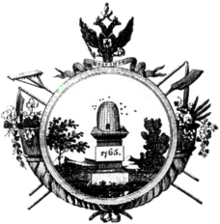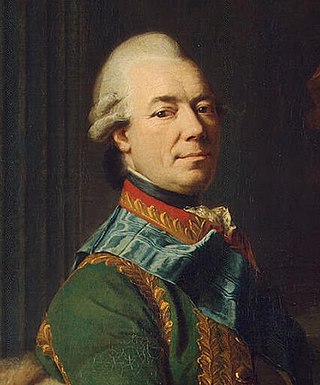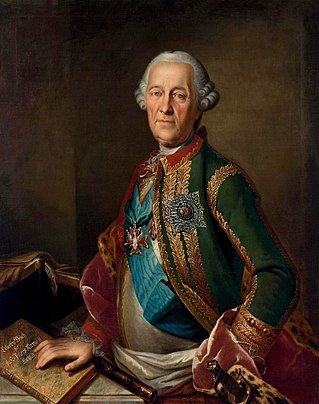| Years in Russia: | 1762 1763 1764 1765 1766 1767 1768 |
| Centuries: | 17th century · 18th century · 19th century |
| Decades: | 1730s 1740s 1750s 1760s 1770s 1780s 1790s |
| Years: | 1762 1763 1764 1765 1766 1767 1768 |

Events from the year 1765 in Russia
| Years in Russia: | 1762 1763 1764 1765 1766 1767 1768 |
| Centuries: | 17th century · 18th century · 19th century |
| Decades: | 1730s 1740s 1750s 1760s 1770s 1780s 1790s |
| Years: | 1762 1763 1764 1765 1766 1767 1768 |

Events from the year 1765 in Russia
| | This section needs expansion. You can help by adding to it. (October 2015) |
| | This section needs expansion. You can help by adding to it. (October 2015) |
| | This section needs expansion. You can help by adding to it. (October 2015) |

Catherine IAlekseevna Mikhailova was the second wife and empress consort of Peter the Great, and empress regnant of Russia from 1725 until her death in 1727.

Catherine II, most commonly known as Catherine the Great, was the reigning empress of Russia from 1762 to 1796. She came to power after overthrowing her husband, Peter III. Under her long reign, inspired by the ideas of the Enlightenment, Russia experienced a renaissance of culture and sciences, which led to the founding of many new cities, universities, and theatres, along with large-scale immigration from the rest of Europe and the recognition of Russia as one of the great powers of Europe.
Enlightened absolutism, also called enlightened despotism, refers to the conduct and policies of European absolute monarchs during the 18th and early 19th centuries who were influenced by the ideas of the Enlightenment, espousing them to enhance their power. The concept originated during the Enlightenment period in the 18th and into the early 19th centuries. An enlightened absolutist is a non-democratic or authoritarian leader who exercises their political power based upon the principles of the Enlightenment. Enlightened monarchs distinguished themselves from ordinary rulers by claiming to rule for their subjects' well-being. John Stuart Mill stated that despotism is a legitimate mode of government in dealing with barbarians, provided the end be their improvement.

Zakhar Grigoryevich Chernyshev was a Russian noble, courtier to Catherine the Great, Imperial Russian Army officer, and Imperial Russian politician in the 18th century.

Burkhard Christoph Graf von Münnich was a German-born army officer who became a field marshal and political figure in the Russian Empire. He carried out major reforms in the Russian Army and founded several elite military formations during the reign of Empress Anna of Russia. As a statesman, he is regarded as the founder of Russian philhellenism. Like his father, Münnich was an engineer and a specialist in hydrotechnology. He had the rank of count of the Holy Roman Empire of the German Nation.

Sloboda Ukraine, usually referred to locally as Slobozhanshchyna, is a historical region located in northeastern Ukraine and southwestern Russia. It developed and flourished in the 17th and 18th centuries on the southwestern frontier of the Tsardom of Russia. In 1765, it was converted into the Sloboda Ukraine Governorate.

The Preobrazhensky Life-Guards Regiment was a regiment of the Imperial Guard of the Imperial Russian Army from 1683 to 1917.

Count, then Prince Nikolay Ivanovich Saltykov, a member of the Saltykov noble family, was a Russian Imperial Field Marshal and courtier best known as the tutor of the eventual Tsar Paul I of Russia and his two sons, Constantine and Alexander.

The relations between the Russian Empire and the United States (1776–1917) predate the Soviet Russia/Soviet Union–United States relations (1917–1991) and the modern Russia–United States relations (1991–present). Russia officially recognized the United States in 1803, and the two countries established diplomatic relations in 1809. From 1776 to 1917 the US and Russia maintained cordial relations, with occasional cultural and commercial exchanges. Russia was neutral during the American Civil War, but tended to favor the North; in contrast to Britain’s policy of favoring The South. It sold Alaska on favorable terms in 1867. However, there were also tensions between the two countries, particularly over mistreatment of Jews in Russia in the 1890-1914 era. Trade relations were cordial but were never a major factor for either nation. Large-scale migration from Russia began in the late 19th century. Minorities emigrated to the U.S. especially Jews, Poles, Lithuanians, and Finns, but few ethnic Russians. In the late 19th century, the two countries began to cooperate on issues such as maritime law and trade. This cooperation continued into the early 20th century. The U.S. was reluctant to become an ally of the undemocratic Tsar in World War I. His abdication in early 1917 facilitated American entry into the war. Overall, the relations were characterized by occasional cooperation and limited engagement, with both countries primarily focused on their own domestic and international priorities.

Vvedenskoye Cemetery is a historic cemetery in Lefortovo District of Moscow in Russia.

Count Pavel Sergeevich Potemkin, sometimes spelled Potyomkin or Potiomkin was a Russian statesman, soldier, and writer.
Riga Governorate, also known as the Province of Riga, was an administrative division of the Russian Empire in modern southern Estonia and northern Latvia from 1713 to 1783. The Province of Riga was formed to replace the Eastern Provinces of the Kingdom of Sweden in 1713. After the conquest of the regions of Ingermanland, Livonia and Estonia by Sweden in the Great Northern War in 1710. In 1713, the Provinces of Riga and Tallinn were separated into separate administrative units, and in 1713–1714, the organization and management of the Province of Riga were also defined.

The Kharkov Governorate was a governorate of the Russian Empire founded in 1835. It embraced the historical region of Sloboda Ukraine. From 1765 to 1780 and from 1796 to 1835 the governorate was called the Sloboda Ukraine Governorate. In 1780-1796 there existed the Kharkov Viceroyalty.

The Imperial Russian Army or Russian Imperial Army was the armed land force of the Russian Empire, active from 1721 until the Russian Revolution of 1917. It was organized into a standing army and a state militia. The standing army consisted of regular troops and two forces that served on separate regulations: the Cossack troops and the Muslim troops.
The Izmaylovsky Regiment, also Izmailovsky, was one of the oldest regiments of the Imperial Russian Army, a subdivision of the 1st Guards Infantry Division of the Imperial Russian Guard. It was formed in Moscow on 22 September 1730 as Empress Anna's personal life guards, named after the Romanov ancestral estate of Izmaylovo.
The Russian plague epidemic of 1770–1772, also known as the Plague of 1771, was the last large-scale outbreak of plague in central Russia, claiming between 52,000 and 100,000 lives in Moscow alone. The bubonic plague epidemic that originated in the Moldovan theatre of the 1768–1774 Russian-Turkish war in January 1770 swept northward through Ukraine and central Russia, peaking in Moscow in September 1771 and causing the Plague Riot. The epidemic reshaped the map of Moscow, as new cemeteries were established beyond the 18th-century city limits.

Novorossiya Governorate, was a governorate of the Russian Empire in the previously Ottoman and Cossack territories, that existed from 1764 until the 1783 administrative reform. It was created and governed according to the "Plan for the Colonization of New Russia Governorate" issued by the Russian Senate. It became the first region in Russia where Catherine the Great allowed foreign Jews to settle.

Novorossiya is a historical name, used during the era of the Russian Empire for an administrative area that would later become the southern mainland of Ukraine: the region immediately north of the Black Sea and Crimea. The province fell largely within a slightly wider area known in Ukrainian as the Stepovyna "Steppe Land", or Nyz "Lower Land". The name Novorossiya, which means New Russia, entered official usage in 1764, after the Russian Empire conquered the Crimean Khanate, and annexed its territories, when Novorossiya Governorate was founded. Official usage of the name ceased after 1917, when the entire area was incorporated in the Ukrainian People's Republic.

The Battle of Kobrin, or the Battle of Kobryn, was a battle that took place on 27 July 1812 between the Russian and Saxon forces in the city of Kobrin (Kobryn) at the initial stage of the French invasion of Russia. The battle was a clear victory of the Russian forces.

The abolition of the Cossack system in Sloboda Ukraine was an administrative and military reform of the government of the Russian Empire, carried out in 1763-1765 and aimed at eliminating the autonomy of the Sloboda Cossack regiments. As a result of the reform, Russian state institutions began to operate on the territory of Sloboda Ukraine, and the Cossack regiments were reformed into Hussar regiments. The Kharkov Governorate with its center in Kharkiv was formed on the territory of the Sloboda regiments.
![]() Media related to 1765 in the Russian Empire at Wikimedia Commons
Media related to 1765 in the Russian Empire at Wikimedia Commons